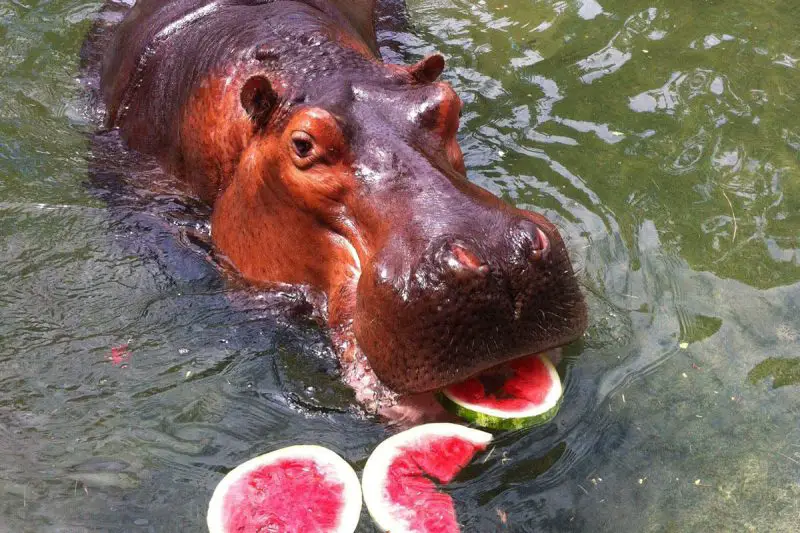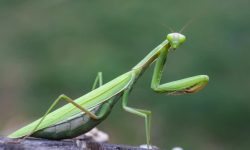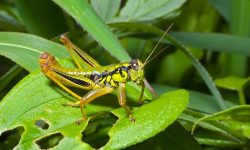Hippos are some of Africa’s most iconic and fascinating animals. These massive, semi-aquatic mammals spend most of their time lounging in rivers and lakes to stay cool under the blazing sun. But when the night falls, they leave the water in search of food. Have you ever wondered — what do hippos eat to maintain their enormous size and strength?
Despite their intimidating appearance and large tusks, hippos are herbivores. Their diet mainly consists of grasses, plants, and occasionally fruit. A full-grown hippopotamus can weigh up to 3,000–4,000 pounds (1,400–1,800 kg), and yet it survives on vegetation alone.
In this detailed guide, we’ll uncover 20 foods hippos love the most, explain how and when they eat, and explore how their diet influences Africa’s ecosystems.
Understanding the Hippo’s Diet

Hippos Are Herbivores — But Unique Ones
Unlike other large herbivores such as elephants or rhinos, hippos have a surprisingly simple diet. They primarily eat short grasses, which they graze at night. However, their massive size means they must consume large quantities of food — up to 80–100 pounds (35–45 kg) of vegetation every night.
Although hippos are often seen in the water, they rarely eat aquatic plants. Instead, they wade out at sunset and travel for miles on land to graze.
How Hippos Eat
Hippos use their broad, muscular lips to clip grass close to the ground — much like a living lawnmower. Their large molars grind down fibrous plants efficiently. Unlike cows or goats, hippos are non-ruminants, meaning they do not regurgitate or re-chew food.
Their stomachs, however, are multi-chambered and specially adapted for fermenting vegetation, which helps them digest fibrous plant material.
When Do Hippos Eat?
Hippos are nocturnal feeders, which means they feed mostly at night. During the day, they stay submerged in water to avoid heat and dehydration. At dusk, they emerge from rivers and walk long distances — sometimes over six miles (10 km) — to find fresh grass.
This nightly grazing routine allows them to consume enough calories while staying safe from the African sun.
20 Foods Hippos Love the Most
1. Short Grasses
Grasses are the primary and most important part of a hippo’s diet. They prefer short, soft grasses such as Bermuda grass and red oat grass, which are abundant in African savannas.
These grasses are rich in carbohydrates and fiber, providing steady energy for hippos to maintain their immense size.
Most of their feeding time is spent grazing low to the ground, clipping grass with precision.
2. African Ryegrass
African ryegrass is another staple food for hippos. It grows in wet areas near rivers and floodplains, making it easily accessible to these semi-aquatic giants.
Ryegrass is nutritious and high in moisture, which helps hippos stay hydrated even when away from water.
During rainy seasons, hippos gorge on fresh ryegrass to store fat for drier months.
3. Water Hyacinth
Although hippos rarely eat aquatic plants, some populations feed on water hyacinth, an invasive floating plant found in African rivers.
This plant is rich in fiber and provides a supplementary food source when grass is scarce.
However, water hyacinth can be difficult to digest in large quantities, so hippos only nibble on it occasionally.
4. Papyrus
Papyrus grows along riverbanks and wetlands, offering both shelter and occasional food for hippos.
They eat the tender shoots and outer layers of the plant, which are easier to chew. Papyrus also provides hydration due to its high water content.
In some regions, papyrus becomes a key food source during dry seasons when grass is less available.
5. Reeds
Reeds and tall grasses found near lakes and marshes form part of the hippo’s diet, especially during droughts.
While not as nutritious as fresh savanna grass, reeds offer fiber and moisture that help maintain digestion.
Hippos often wade into shallow water to feed on reed beds along the shoreline.
6. Fruit (Occasionally)
Although not a major food, hippos sometimes eat wild fruits like figs, melons, and fallen mangos.
These fruits provide natural sugars and vitamins that offer quick energy. Fruit consumption is more common in forested or mixed habitats where trees are abundant.
Wild fruits also help hydrate hippos during dry seasons, though they remain secondary to grass.
7. Aquatic Vegetation
Some hippos feed on soft aquatic plants like duckweed and water lilies, especially those living in deep wetlands.
These plants are easy to chew and contain minerals that promote healthy digestion.
While aquatic vegetation isn’t their main diet, it helps supplement nutrients when grazing land is scarce.
8. Algae
Algae growing along rocks or in shallow ponds sometimes serve as food for hippos.
They scrape algae off surfaces while moving through the water, unintentionally feeding as they wallow. Algae are rich in minerals and help maintain their skin health.
This incidental feeding helps clean waterways and prevent algae overgrowth.
9. Bush Stems
During the dry season, when green grass disappears, hippos may eat small bushes or stems of woody plants.
Though coarse and harder to digest, these stems provide roughage and help sustain them until rains return.
Their strong molars can grind tough plant material with ease.
10. Fallen Leaves
Hippos sometimes browse on fallen leaves near forest edges or riverbanks.
Leaves provide a mix of nutrients and are easier to chew when fresh and moist.
This browsing behavior is rare but shows their adaptability to seasonal food changes.
11. Maize (Corn)
In areas near farmlands, hippos occasionally raid maize fields at night. Corn provides concentrated energy in the form of starch and sugar.
While this behavior causes conflict with farmers, it’s a testament to the hippo’s intelligence and adaptability.
Corn also helps hippos store fat quickly during food shortages.
12. Sugarcane
Like elephants, hippos love sugarcane for its sweet, juicy stalks. They break the stems with their jaws and chew the soft inner pulp.
Sugarcane provides instant energy and hydration, making it an irresistible food in cultivated areas.
Farmers in Africa often use barriers to keep hungry hippos out of sugarcane fields.
13. Wild Millet
Wild millet and other small grasses grow along savanna wetlands. Hippos graze on these plants, which are rich in fiber and nutrients.
These small plants sprout quickly after rainfall, offering abundant food for grazing herds.
Millet helps hippos maintain their digestion and stamina throughout the dry season.
14. Rice and Paddy Plants
In floodplain regions, hippos sometimes enter rice paddies to feed on young rice shoots.
These plants provide both energy and moisture. Unfortunately, this habit often leads to human–wildlife conflicts in agricultural zones.
Despite this, rice plants offer valuable nutrition that supports hippos during droughts.
15. Soft Shrubs
Hippos occasionally browse on soft shrubs or young shoots growing near the water’s edge.
These plants contain tender leaves and stems that are easier to digest than woody bushes.
This browsing provides variety in their diet and ensures they consume a range of plant nutrients.
16. Cattails
Cattails, also known as bulrushes, grow abundantly in wetlands. Hippos feed on their stems and leaves, which are full of water and fiber.
Feeding on cattails helps hippos stay hydrated while providing roughage for digestion.
In many regions, cattails form an important backup food when terrestrial grasslands dry up.
17. Barley and Other Crops
Like many large herbivores, hippos sometimes venture into barley, sorghum, or wheat fields at night.
These crops are rich in carbohydrates and help them build energy reserves quickly.
This crop-feeding behavior shows how hippos can adapt to changing food availability.
18. Acacia Shoots
Although acacia trees are better known for feeding giraffes, hippos occasionally nibble on the lower branches and shoots.
The shoots are tender and high in minerals. In some habitats, acacia plants serve as seasonal food sources when grasses are sparse.
This feeding behavior also prunes low branches, promoting new growth in acacia woodlands.
19. Legumes
Wild legumes such as beans or groundnuts provide protein and nutrients for hippos.
While not a major food group, legumes help hippos build muscle and maintain body strength.
In agricultural regions, they may consume cultivated legumes when foraging at night.
20. Clay and Mineral-Rich Soil
Like elephants, hippos sometimes consume small amounts of clay or mineral soil, a behavior known as geophagy.
This provides essential minerals such as sodium and calcium, which are lacking in grasses.
It also helps neutralize plant toxins and supports digestion.
Why Hippos Eat the Way They Do
Efficient Grazers
Hippos’ unique mouths are perfectly adapted for grazing. Their wide lips and powerful jaws allow them to pull grass close to the ground efficiently.
They typically feed for 4–5 hours per night, consuming vast amounts quickly before returning to the water by dawn.
Energy Conservation
Despite their size, hippos have a low metabolic rate, meaning they can survive on surprisingly little food compared to their mass.
This adaptation helps them endure periods of drought or food scarcity.
Ecological Impact
Hippos play an important role in maintaining ecosystems. Their nightly grazing shapes grasslands, while their dung enriches rivers and supports aquatic life.
They also disperse plant seeds through their feces, helping vegetation regrow naturally.
Frequently Asked Questions (FAQs)
Do hippos eat meat?
No. Hippos are strict herbivores and do not eat meat. Although there have been rare reports of hippos eating carcasses, these are considered abnormal or stress-related behaviors.
How much do hippos eat per day?
An adult hippo eats about 80–100 pounds (35–45 kg) of vegetation every night, depending on its size and food availability.
Do hippos eat fish?
No. Hippos do not actively hunt or eat fish. Their digestive systems are not designed for animal protein.
Why do hippos leave the water to eat?
Hippos feed on land because the grasses they prefer do not grow underwater. They leave rivers and lakes at night to graze on terrestrial vegetation.
What do baby hippos eat?
Baby hippos nurse on their mother’s milk for the first six to eight months. Gradually, they begin grazing on grass alongside adults.
Conclusion
Hippos are majestic creatures that thrive on a simple but powerful diet. From lush African grasses and reeds to occasional fruits and crops, their herbivorous lifestyle sustains their immense strength and energy.
Their feeding habits also shape the landscapes around them — trimming vegetation, enriching soil, and maintaining the delicate balance between land and water ecosystems.
So next time you see a hippo yawning in a river or grazing under the moonlight, remember: behind that massive mouth is nature’s most peaceful giant, powered entirely by plants.






